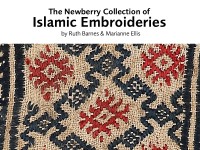The Newberry Collection of Islamic Embroideries
An unpublished catalogue of the Ashmolean’s collection of Islamic embroideries from Egyptologist Percy Newberry, by Ruth Barnes and Marianne Ellis.

Publications online: 1018 objects
- Reference URL
Actions
Textile fragment with quatrefoils and interlacing kufic script
-
Literature notes
A field with a diamond pattern filled with quatrefoils and interlacing is followed by a line of drawn thread and a band of interlace kufic. The outlines of diamonds, quatrefoils, and scrolled interlacing are embroidered with flax thread, the background is filled with silk thread.
The embroidery is extremely fine. An additional fragment of plain tabby linen is sewn to the kufic band with a flat seam.
The uncalibrated radiocarbon date is 1036 AD +/- 35, but the calibrated date of 1030 to 1210 may place the textile into the post-Fatimid period, which is likely on stylistic grounds. -
Details
- Associated place
-
Near East (place of creation)
- Date
-
late 12th century - early 13th century
Ayyubid Period (1169 - 1260)
- Material and technique
- linen, embroidered with brown, blue, and purple silk, and undyed flax; additional piece of linen; joined with a flat seam in flax
- Dimensions
-
13 x 9.5 cm (length x width)
along length/width 22 / 22 threads/cm (thread count)
ground fabric 0.05 cm max. (thread diameter)
ground fabric 0.03 cm min. (thread diameter)
additional fibre, embroidery 0.03 cm (thread diameter)
- Material index
-
organic › animal › animal product › silk,
- Technique index
-
woven › plain woven,assembled › woven › plain woven,
- Object type index
- No. of items
- 1
- Credit line
- Presented by Professor Percy Newberry, 1941.
- Accession no.
- EA1984.108
-
Further reading
Barnes, Ruth and Marianne Ellis, ‘The Newberry Collection of Islamic Embroideries’, 4 vols, 2001, Oxford, Ashmolean Museum, cat. vol. ii, vol. i p. 20, illus. vol. i
Glossary
kufic
-
kufic
A term denoting various styles of angular Arabic script. Emerged in the early centuries of Islam, kufic soon became the preferred hand to copy holy texts.
Location
-
- currently in research collection
Objects are sometimes moved to a different location. Our object location data is usually updated on a monthly basis. Contact the Jameel Study Centre if you are planning to visit the museum to see a particular object on display, or would like to arrange an appointment to see an object in our reserve collections.
Galleries
Collection trails
Publications online
-

The Newberry Collection of Islamic Embroideries
A field with a diamond pattern filled with quatrefoils and interlacing is followed by a line of drawn thread and a band of interlace kufic. The outlines of diamonds, quatrefoils, and scrolled interlacing are embroidered with flax thread, the background is filled with silk thread.
The embroidery is extremely fine. An additional fragment of plain tabby linen is sewn to the kufic band with a flat seam.
The uncalibrated radiocarbon date is 1036 AD +/- 35, but the calibrated date of 1030 to 1210 may place the textile into the post-Fatimid period, which is likely on stylistic grounds.
Notice
Object information may not accurately reflect the actual contents of the original publication, since our online objects contain current information held in our collections database. Click on 'buy this publication' to purchase printed versions of our online publications, where available, or contact the Jameel Study Centre to arrange access to books on our collections that are now out of print.
© 2013 University of Oxford - Ashmolean Museum




